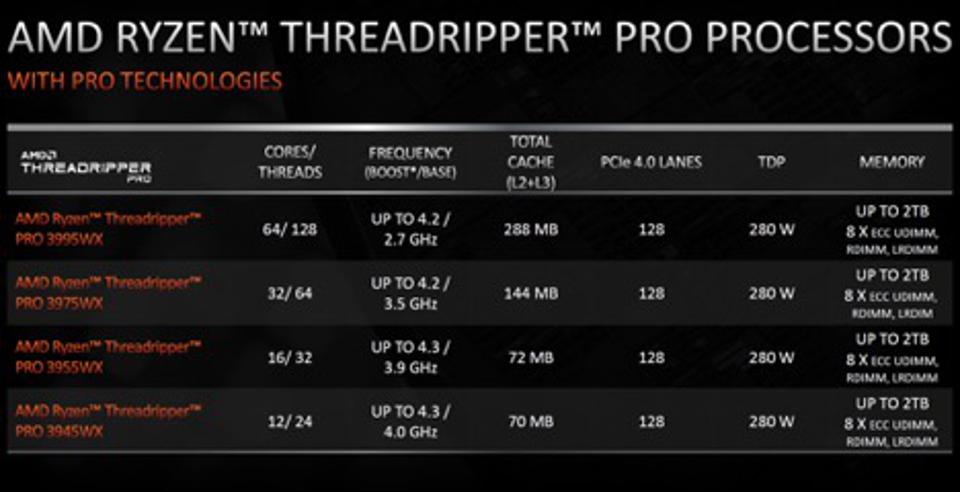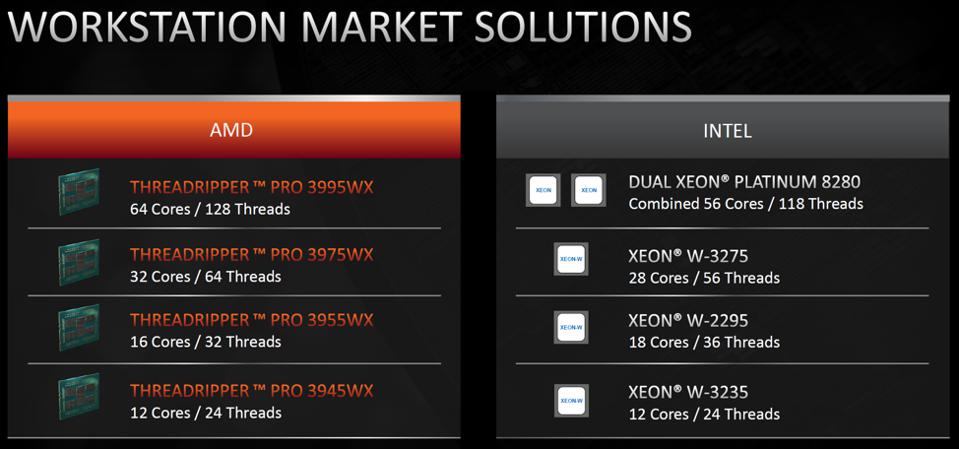It is no secret that AMD has been on a tear lately, and one of the company’s biggest successes as of late is the high-end desktop PC category. Some of that high-end desktop momentum has also resulted in many prosumers and independent creators adopting AMD’s processors for their workstations at home and/or at work. While AMD has struggled to get its chips into workstations from major tier 1 OEMs, that appears to be changing as well with the newly announced Ryzen Pro workstation CPUs and Lenovo ThinkStation P620. Let’s take a look at the new offerings.
A new family has Ryzen
With the new Ryzen Threadripper Pro line of processors, AMD is delineating between workstation, server and high-end consumer in a way it never has before. AMD previously lumped professional workstation users in with the Ryzen Threadripper category, which has the same core counts but not the same kind of memory or I/O. AMD is also introducing a new WRX8 socket to support this new processor, because while the cores may be the same, it features 128 PCIe lanes per CPU and up to 2TB of DRAM via 8-channel ECC UDIMM, RDIMM or LRDIMM. The ability to support RAM capacities up to 2TB also means that AMD wants to enable the leading game and movie studios to load as much of their assets to RAM as needed. Data scientists can also take advantage of these larger capacities when running their models. All four processors also feature a 280W TDP and vary in Zen 2 architecture core count, from 12 to 64. The L2 and L3 cache also varies, from 70 MB to 288 MB based on core count.

AMD
Some may criticize AMD for introducing yet another new socket, but the company says that it intends to give this socket similar longevity to its AM4 and SP3 sockets, which have gone through multiple generations. Additionally, AMD points out that Intel offers 3 different platforms, with dozens of different processors, with different feature sets—all to satisfy the same market. While this may be true, Intel also has a significantly larger portion of the market. I believe that if AMD’s claims around simplicity are true, it should be able to show significant share gains.
AMD considers Intel’s Xeon Platinum 8280 dual socket (two 28-core CPUs) to be the closest competitor to its 64-core Threadripper Pro 3995WX. The Threadripper Pro 3975WX is supposed to compete against Intel’s 28-Core Xeon W-3275, and the 16-core Threadripper Pro 3955WX is supposed to compete with the 18-core Xeon W-2295. In fact, the only product that both companies appear to have that match one another in core count is at the bottom of the stack—a 12-Core offering, the Threadripper Pro 3945WX, against the Intel Xeon W-3235.

AMD
Performance
Since AMD’s Ryzen Threadripper Pro 3945WX is the closest competitor to what Intel has to offer core per core, AMD decided to use it as the benchmark for performance. AMD used Cinebench R20 single thread and multi-thread to compare the performance difference and the company showed a 12% difference in single core performance and a 28% difference in multi-threaded—astonishing, when you consider how expensive these processors can be. At the high-end AMD also used the latest version of SPECviewperf, SPECviewperf 13, to test the Ryzen Threadripper Pro 3995WX against two Intel Xeon 8280 processors. It found performance improvements across all workloads, ranging from 4% to 37%. This is particularly impressive because it is an industry-accepted workstation benchmark. Even in apps like Adobe After Effects and Premiere Pro, AMD’s Ryzen Threadripper Pro 3995WX was as much as 52% and 25% faster, respectively. These and the other numbers AMD showed off are difficult to ignore, and I believe they will be welcomed by the creative community. AMD even got buy-in for the new processors from a VFX studio, Jellyfish Pictures, and the game engine wizards at Epic Games.
Wrapping up
The new AMD Ryzen Threadripper Pro family of processors will only be available through OEM channels for the time being. This means that there are currently no prices on these processors, and that OEMs, like Lenovo, will ultimately set those prices. Lenovo will pair these new AMD Ryzen Threadripper Pro processors with both NVIDIA and AMD professional graphics cards inside the new ThinkStation P620, available this fall. Since the system is not yet available for pre-order, so we can’t ball-park the pricing beyond what we’ve seen from the Ryzen Threadripper 3990X. Going off of that, the Ryzen Threadripper Pro 3995WX could go for upwards of $4,000. I believe it is a good move for AMD to offer more high-margin products that provide alternatives to Intel at a competitive price. Time will tell, but I believe that it will take more than Lenovo’s adoption of the Threadripper Pro series to really make a meaningful dent in workstation market share. I’ll continue to watch with interest.
Patrick founded the firm based on his real-world world technology experiences with the understanding of what he wasn’t getting from analysts and consultants. Ten years later, Patrick is ranked #1 among technology industry analysts in terms of “power” (ARInsights) in “press citations” (Apollo Research). Moorhead is a contributor at Forbes and frequently appears on CNBC. He is a broad-based analyst covering a wide variety of topics including the cloud, enterprise SaaS, collaboration, client computing, and semiconductors. He has 30 years of experience including 15 years of executive experience at high tech companies (NCR, AT&T, Compaq, now HP, and AMD) leading strategy, product management, product marketing, and corporate marketing, including three industry board appointments.
- Patrick Moorheadhttps://moorinsightsstrategy.com/author/phfmphfmgmail-com/
- Patrick Moorheadhttps://moorinsightsstrategy.com/author/phfmphfmgmail-com/
- Patrick Moorheadhttps://moorinsightsstrategy.com/author/phfmphfmgmail-com/
- Patrick Moorheadhttps://moorinsightsstrategy.com/author/phfmphfmgmail-com/






















































































